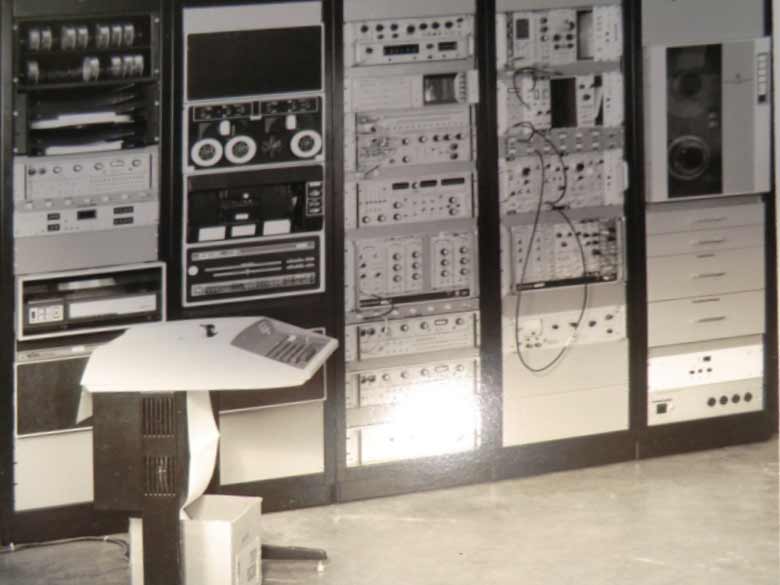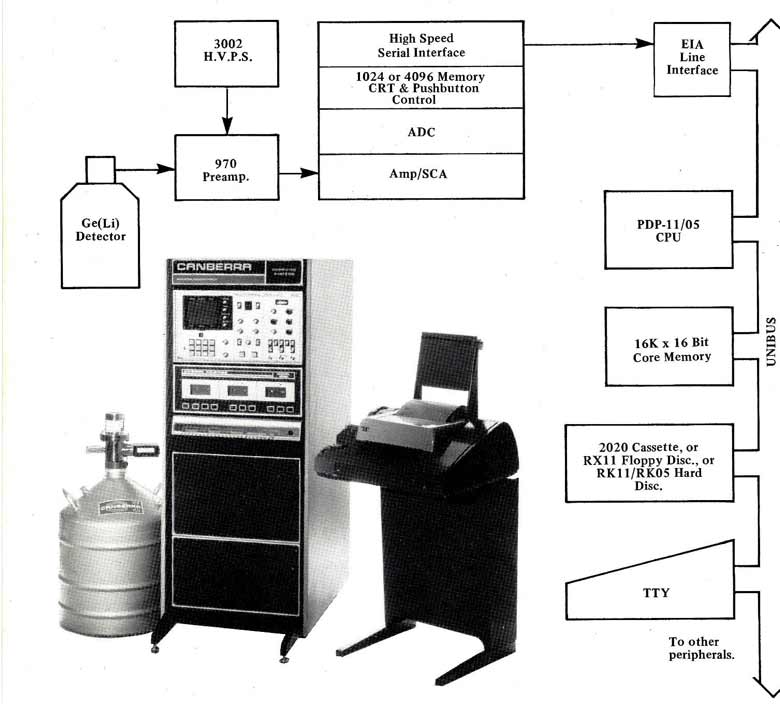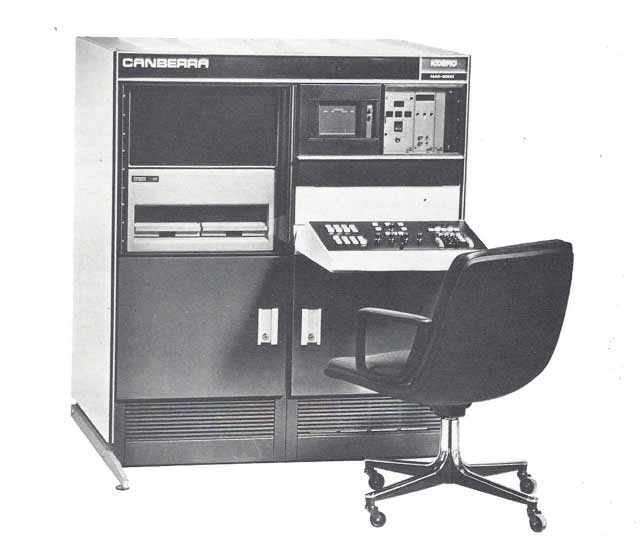-
Computer Systems
with Markku Koskelo and Gene SengstockDEC-Based Computer Systems
The first MCA-Computer system offered by Canberra was the 8700/Quanta which comprised the re-badged Geoscience 7000 MCA connected to a DEC PDP-11. This came about in the early 1970s after Canberra acquired the Geoscience MCA product line and gained the services of Harvey Roberts and his engineering team.
 This is a GEOS 7000 Quanta system sold to Jack Parker and John Lundgren at LANL. Two GEOS 7000s can be seen at the bottom of the center rack. Photo from Harvey Roberts
This is a GEOS 7000 Quanta system sold to Jack Parker and John Lundgren at LANL. Two GEOS 7000s can be seen at the bottom of the center rack. Photo from Harvey RobertsBy the early 1970s, Canberra had introduced the 8100/Quanta Computer-Based MCA System with the 8100 MCA interfaced to a DEC PDP-11. The Canberra 2020 Triple Cassette Recorder was an option for (very slow) mass storage and the Canberra-developed CLASS software, written by Gene Sengstock and Steve Piner, along with Spectran, an early gamma ray analysis package. A later version of the Quanta was dubbed RT/Quanta. Larry East joined Canberra in 1975. He made some modifications to Spectran, and this new version was called Spectran II. With Steve Piner the CLASS Interpreter was converted to run under DEC’s RT-11 and finally under Fortran with new features including least-squares peak fitting and better display capability. This version was known as Spectran-F.

A year or two later Scorpio was introduced. Scorpio featured a pushbutton control panel which could call up MCA and analysis functions. Scorpio morphed into several flavors including the Scorpio 2000 Disk-Based Computer System and the Scorpio 3000 Multi-Unibus (an oxymoron?) Disk-Based Computer System, having a secondary bus for data acquisition so as not to burden the CPU.
According to Harvey Roberts, Les Daniels was the hardware designer for this product. Mary MacIlvain (formerly Mary LaRosa) did all the programming for the system in Fortran and Macro-11 assembler (machine code). Scorpio gave users more flexibility in programming than did earlier Canberra computer systems but it met with stiff competition from Nuclear Data.
 The Scorpio 3000 with the Scorpio pushbutton control panel (for MCA lovers)
The Scorpio 3000 with the Scorpio pushbutton control panel (for MCA lovers)By 1979, the RT/Quanta and the Scorpios 2000 and 3000 were joined by the JUPITER which looked a lot like the 8100/Quanta with a Series 80 MCA instead of the 8100 front end. By 1981 only JUPITER remained in the product line.
When Markku Koskelo joined Canberra in 1982, the company embarked on a new analysis package which came to be known as APOGEE. It included a number of algorithms from the SAMPO code that Markku brought with him. Most of the coding was done in 1982 and 1983 by Markku and Jeorg Siefert from our German office. It ran on both the PDP-11 and the VAX. APOGEE was more modular and had a more modern, user-friendly interface than Spectran so the latter never made the transition into the VAX world.
In the mid-1980s there were two versions of JUPITER distinguished by their front-end MCAs: the S-35+, the S-85, and by the analysis software running on their DEC CPUs: Spectran-F running on PDP-11 CPUs under RT-11, Spectran-F and APOGEE running under the RXS-11 operating system and APOGEE running under VMS on the VAX-11. With the advent of the Series 90 MCA came another system name, GEMINI running also on the PDP-11 and the VAX-11. System names were cheap enough so we chose this new one for this combination which was, in essence, just another JUPITER with a different MCA front end. Maybe we did this just to confuse the competition. Who knows? What might now be called “badge engineering” was not uncommon in Canberra history. Anyway such exercises became known within Canberra as “painting the Jeep”, an expression of unknown origin (Gilligan’s Island?)parroted by Gene DellaVecchia.
Somehow Canberra managed to stay competitive despite this eclectic assortment of computer-based systems until Nuclear Data was acquired in 1989, whereupon the ND Genie System was adopted. The VAX- Based Genie powered all Canberra systems for a few years until the PC could no longer be ignored whereupon, in 1992, the Genie-PC under IBM’s doomed OS/2 Operating System was introduced. This low-end product helped competitively, but it threatened the more lucrative DEC-Based business. Thanks to stalwarts like Cameron Seely who fought furiously to keep PCs out of our lucrative nuclear power accounts: “We must not get down in the mud and wrestle with these cheap suppliers”, the VAX-based Genie continued to sell well for many more years. Thus Canberra made the transition to the PC world without self-cannibalization. Surely this was the fear that prevented DEC from making the transition and they eventually paid the price.
PC-Based Computer Systems
In the mid-1980s the IBM Personal Computer was becoming a popular alternative to the Apple computer that had dominated the home computer market. Early adopters saw the IBM PC as potential competitor to DEC for instruments and systems. Although it was not offered much encouragement, as sort of a “skunkworks project”, Stan Wawrowski, managed to get a version of Spectran to work on the PC under DOS. This version was called Spectran-AT.
Somehow Les Daniels got his hands on an early version of Microsoft Windows, and showed it around Canberra. The multi-tasking capability was demonstrated by the simultaneous display of a clock face and another program. I don’t believe we were impressed. Little did we know!
According to, David Coffey, the founder of The Nucleus, his company was the first to recognize the possibility of building an MCA using a plug-in card and a PC. This product and others from other suppliers including APTEC quickly gained a share of the low-end MCA market and signaled the coming end of the hard-wired MCA business. Canberra’s first PC-MCA was the System 100, running under MS Windows. The S-100 had a really nice user interface and it became a very popular product. When Canberra bought ND in 1989, they had three PC board products dubbed Accuspec (running under DOS) that complemented the S-100.
To rationalize this PC-based product line, a group of Canberra and former ND marketing and software people worked together to redesign the data acquisition and analysis platform. Markku Koskelo, Randy Shepard, and Bud Sielaff from Meriden and Mark Mercier, Bob Huckins, and Chuck Scheckel from ND were involved with this effort which led to Genie-PC operating on the IBM OS/2 platform. Their choice of OS/2 over Windows was completely rational at the time because it was a true multi-tasking operating system which Windows was not at that time and thus was better suited to our application. We did not realize that Microsoft would soon overwhelm OS/2, however, and after a year or two the software was converted to run under MS Windows and became known as Genie-2000. With updates from time to time, Genie-2000 has survived until this day.